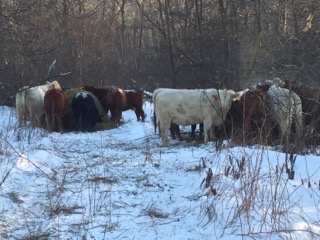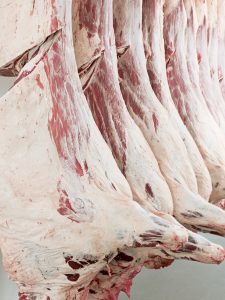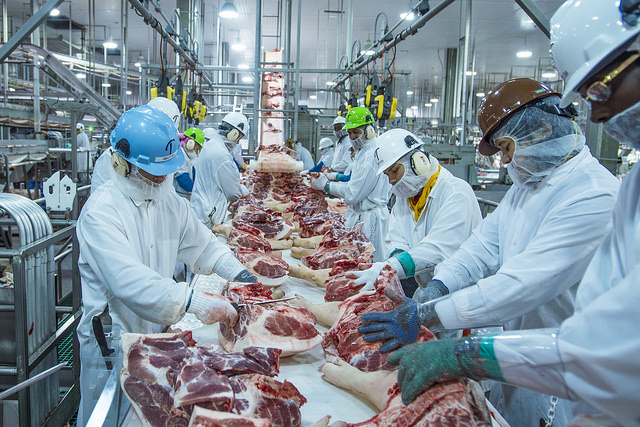



Weekly beef and dairy digest: USDA issues in-depth reports on US and Canada's cattle markets
Canada's cattle herd continues to decline and US beef exports to Japan reach their annual limit, triggering tariffs.USDA's monthly cattle and dairy outlook
Cattle and beef
The first-quarter beef production forecast was lowered from last month on slaughter disruptions caused by weather events that gripped the Plains in mid-February. However, a shift in fed cattle slaughter from the first quarter and into the second, along with higher expected cow slaughter in the first half, more than offset that decline. As a result, the 2021 beef production forecast was raised to 27.6 billion pounds.
Because of the weather disruption to packing facilities in February, fed cattle prices lacked support from the cut-out and remain unchanged from last month. January beef imports totaled 224 million pounds, down 8.1% from a year ago on the lowest shipments from Australia since 2005.

The 2021 annual beef import forecast was revised down due to anticipated low shipments from Australia and New Zealand and greater beef demand competition from Asia. Beef exports in January totaled 246 million pounds, up less than 1 million pounds year over year, reflecting robust exports to China. The first-quarter forecast for beef exports was unchanged from last month at 750 million pounds.
Dairy
The all-milk price forecast for 2021 has been raised to $17.75 per hundredweight, $0.60 higher than last month’s forecast. The milk production forecast is reduced, as lower expected milk per cow more than offsets higher expected milk cow numbers.
Forecasts for domestic use have been raised on both the milk-fat and skim-solids milk-equivalent bases. The forecast for 2021 exports on a milk-fat basis has been raised due to higher expected butter exports. The forecast for exports on a skim-solids basis has been reduced as lower expected lactose exports more than offset higher expected exports of dry skim milk products.
Canada's livestock outlook
USDA this week reported the Canadian cattle herd will continue to contract in 2021. Cattle exports are forecast to decline while beef exports are expected to grow slightly. The United States will remain the top market for both imports and exports of beef and pork.
Revisions by Statistics Canada have resulted in an upward adjustment of beginning cattle stocks for 2021. This is partly attributed to increases in 2020 beginning stocks, a larger calf crop due to increased reproductive performance, and increased imports. An additional factor in this adjustment is that cattle have remained on feed for longer due to set-aside programs created following COVID-19 processing disruptions in 2020.
.jpg)
Despite these revisions, the trend for continued contraction of the Canadian cattle herd continues a steady decline. This decline has been occurring since 2005, following inflation of herd numbers in the years immediately following bovine spongiform encephalopathy (BSE) in Canada in 2003.
Official 2021 beginning inventories have the Canadian herd side reduced one percent on 2020 beginning inventories. Although Canada saw reduced cow slaughter in 2020, this was mainly the result of processing disruptions. Canada increased exports of cull cows to the United States and inventories of beef cows were not rebuilt as expected.
However, beef cow stocks are relatively stable on 2020 beginning stocks following a 4% decline from 2019 to 2020. Early indications suggest that heifer retention will improve in 2021 but this expectation is dependent on weather and good pasture conditions as the year progresses.
Statistics Canada Live cattle exports have been revised downward on the expectation of fewer cull cows moving to the United States as well as fewer feeder cattle. Beef export demand remained strong in 2020 despite many challenges. With the calf crop remaining relatively stable on 2020 volumes and a strong basis for Western feeders, this will support feeder cattle remaining in Canada.
However, feed availability and feed prices and the current strengthening of the Canadian dollar will be a factor. Canada will also have additional slaughter capacity in 2021 compared with 2020 as an Ontario processing plant resumes operations under new ownership. The processing plant was closed in 2019, due to violations of the Safe Food for Canadians Act and Regulations, leaving a gap in Eastern Canada slaughter. The new owners are expected to begin harvest operations at the facility in March 2021 and it is expected to add an additional 1,600 head capacity for Ontario and Eastern Canada.

Earlier indications are that the plant will be primarily focused on slaughtering cattle from branded programs, such as Ontario Corn Fed, with the intent to supply domestic demand to start. There are also reports that smaller processing facilities in Northern Ontario and British Columbia will be coming online in 2021 providing small additions to slaughter capacity.
Despite processing disruptions which created a backlog of cattle in Spring 2020, Canadian cattle feeders once again imported record numbers of US feeder cattle. Sources continue to indicate that these feeder cattle are predominantly dairy steers. With expectations of strong packer demand and improved fed cattle prices, FAS/Ottawa has revised the 2021 forecast to see continued growth in US feeder imports.
Cattle on feed numbers in Western Canada indicate that, despite some cattle remaining on set-aside from the processing backlog, there is pen space to place additional feeders. A strong basis will motivate feeders to fill that pen space. Drought conditions in the United States may also impact the volume of feeder cattle imports as feed availability is impacted.
Significant processing disruptions related to outbreaks of COVID-19 were observed in early 2020 in Alberta and late 2020 in Ontario. Despite these disruptions, 2020 cattle slaughter was only down 3%. When accounting for a smaller cattle herd in 2020 compared with 2019, slaughter was actually proportional to available inventory in 2020 with packers working efficiently to help clear cattle backlogs. Government programs that supported cattle on maintenance rations to help manage market ready numbers were influential in allowing the industry to cope with disruptions associated with COVID-19.
FAS/Ottawa has forecast 2021 slaughter to see 3% growth compared to 2020. Additional processing capacity, a reduction in feeder exports, and increased feeder imports will support this growth. Processing disruptions due to the pandemic remain a concern, however, the vaccination of workers combined with processing plant mitigation measures should see fewer COVID-related processing disruptions in 2021.

Increased domestic production will result in imports declining 12% in 2021, following 22% growth in 2020. 2021 Beef imports are revised upwards by 20,000 metric tonnes (MT) as domestic demand for beef remains strong. While there continue to be adjustments to the level of restrictions and lockdown activity across Canada, it is expected that the situation will improve by summer as a greater proportion of the population is vaccinated. Assuming Canada achieves mass vaccine roll-out by mid-year, this should result in fewer restrictions on food service.
However, a strengthening Canadian dollar could negatively impact export activity. Exports grew 20% from 2019 to 2020 as Canada more than doubled exports to China. The growth in exports to China resulted in reduced export activity in many other top markets. A challenge for 2021 will be whether Canada can sustain export activity to China.
This may be especially difficult as there are currently eight processing plants temporarily suspended from export to China due to COVID-19 cases. This is in addition to the plants that remain temporarily suspended from China since 2019 for non-COVID-1919 reasons. It is estimated that around two-thirds of export eligible production is currently impacted by the temporary suspensions. The re-listing of the suspended plants will be important to achieving sustained export volumes to China.
Industry is confident Canada will continue to see similar export volumes in 2021 by moving 13 back into markets that saw a decline in 2020. Canada will look to increase exports to Japan as well as CPTPP countries.
Beef and agriculture industry headlines from Asia
US beef exports to Japan bumping up against limit, higher duties could be triggered
US beef exports to Japan will likely trigger a safeguard tax hike for the first time since August 2017, pushing tariffs from 25.8% to 38.5% for the next 30 days, Kyodo News reports.

The Japan/US trade agreement that took effect in 2020 includes a maximum 242,000 metric tonnes (MT) in US beef exports per fiscal year, at which point higher tariffs take effect. Through the end of February, the US has exported 233,112 MT of beef to Japan. The fiscal year ends this month. The early March import figure will be released Wednesday. Japanese officials say if the accumulated import volume tops the maximum, the safeguard measure would take effect on Thursday 18 March.
Bloomberg: China plans new food-trading giant with Cofco merger and IPO
China’s largest food company plans to merge its international trading division with several domestic businesses to create a new agricultural commodity behemoth before embarking on an initial public offering, according to Bloomberg News.
Cofco Corp has hired bankers to advise on a plan to combine Cofco International Ltd with some of its domestic trading and processing assets, Bloomberg reported, citing people familiar with the talks. After the merger, Cofco plans to sell shares in the new company, most likely in Shanghai, the people said. The IPO could value the new company at more than $5 billion, the people said.
The new company will compete with the so-called ABCDs, a quartet of global traders which have dominated the industry for decades: Archer-Daniels-Midland Co, Bunge Ltd, Cargill Inc and Louis Dreyfus Co.
TheCattleSite News Desk
IMPORTANT NOTE: I am not a futures broker and do not manage any trading accounts other than my own personal account. It is my goal to point out to you potential trading opportunities. However, it is up to you to: (1) decide when and if you want to initiate any traders and (2) determine the size of any trades you may initiate. Any trades I discuss are hypothetical in nature.
Here is what the Commodity Futures Trading Commission (CFTC) has said about futures trading (and I agree 100%): 1. Trading commodity futures and options is not for everyone. IT IS A VOLATILE, COMPLEX AND RISKY BUSINESS. Before you invest any money in futures or options contracts, you should consider your financial experience, goals and financial resources, and know how much you can afford to lose above and beyond your initial payment to a broker. You should understand commodity futures and options contracts and your obligations in entering into those contracts. You should understand your exposure to risk and other aspects of trading by thoroughly reviewing the risk disclosure documents your broker is required to give you.



